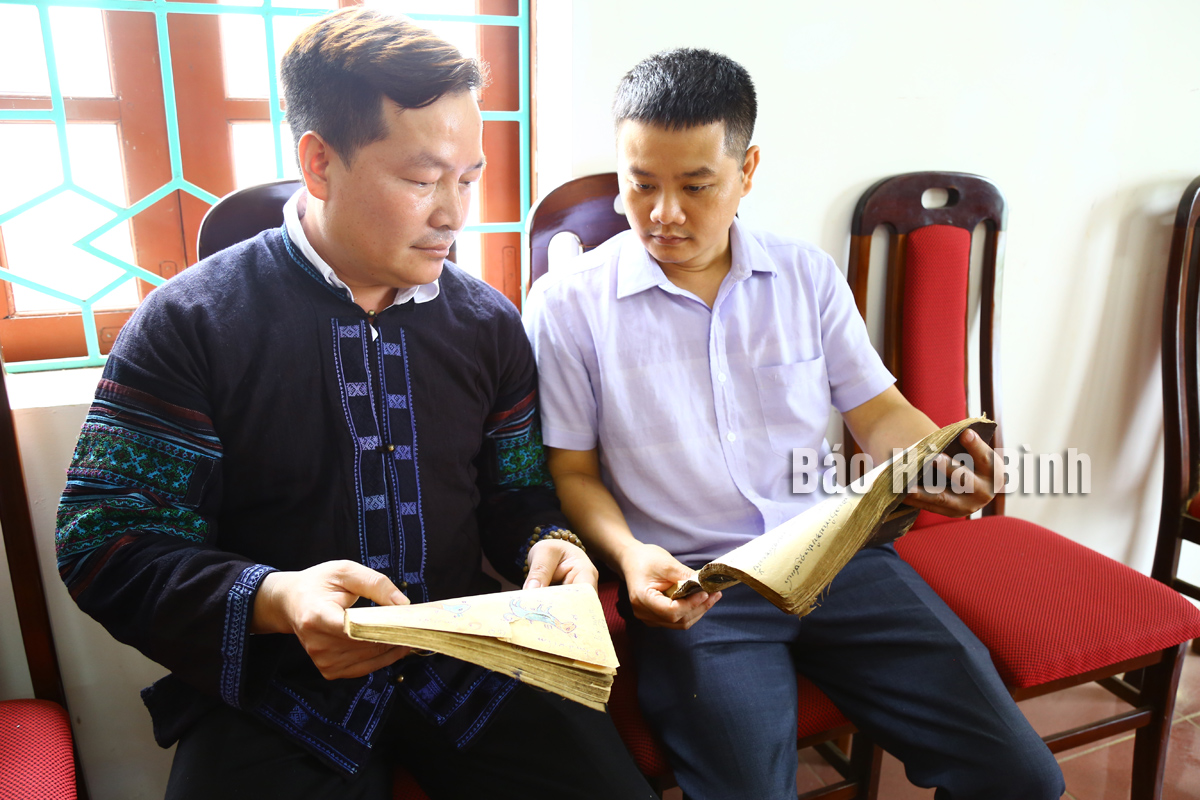
In Muong Chieng commune, Da Bac district, many people know Sa Van Cam, who is dedicated to preserving and promoting ancient Tay script. He has collected, documented and opened classes to teach this script, contributing to the preservation of the Tay ethnic cultural values in Muong Chieng commune and Hoa Binh province.
Sa Van Cam (left), a resident of Muong Chieng commune, Da Bac district, introduces books on ancient Tay scripts that he has preserved and promoted.
Born and grown up in Muong Chieng, where Tay ethnic group makes up over 70% of the population, Cam has accumulated extensive knowledge about Tay culture, including its ancient script. He said that the ancient Tay script has been preserved and handed down through generations. However, in modern times, many cultural values are fading, especially among the youth. To encourage the local Tay community and students to learn and write in their native script, he has studied and set up classes to preserve and promote the Tay language and writing.
Since 2010, Cam has organised seven classes for ancient Tay script, attracting over 200 learners from Muong Chieng and surrounding areas. Notably, in 2017, the Vietnam Institute of Linguistics in Hanoi collaborated him to offer a class on ancient Tay script and held a calligraphy competition in Muong Chieng, with Cam as the instructor. The same year, the Cau Muong festival was held in the commune to promote ancient Tay script to visitors.
Cam held that ancient Tay script differs significantly from the modern Thai script. He collected ancient books passed down to him by his ancestors to compile books and lesson plans to teach the people the Tay language. Despite financial difficulties in running these classes, his passion for imparting ancestral knowledge drives him to continue.
Cam has actively collaborated with the local folk culture club to maintain cultural and artistic activities while teaching ancient Tay script to its members. Many learners in his classes have become proficient in reading and writing the script. Currently, Cam's classes have over 30 attendees who learn three times a week at the community centre in Chieng Cang village.
Nguyen Quang Hieu, Deputy Head of the provincial Emulation - Commendation Commission, highlighted that Cam's model of "preserving and promoting the identity of ancient Tay script" provides significant social benefits by safeguarding and enhancing the Tay script and culture. It helps people better understand the rich and unique culture of the Tay ethnic group, he added. Cam's model has the potential to create a ripple effect and inspire broader influence across the province.
In recognition of his contribution to collecting folk culture, the provincial People’s Committee recognised Cam’s model as a provincial-level advanced example this year.
Gongs hold a special place in the cultural and spiritual life of the Muong ethnic people in Hoa Binh province. More than musical instruments, they are an indispensable part of community rituals and collective memory, echoing through generations as a spiritual thread linking the past, present, and future.
Preserving and promoting the cultural values of the Muong ethnic group has become an urgent task in the current context, as many traditional values face the risk of fading away. This effort requires not only protecting the cultural identity but also eliminating outdated customs and developing a modern cultural lifestyle, contributing to sustainable values for the Muong community in Hoa Binh province.
The Muong ethnic culture, deeply rooted in Vietnam’s mountainous north, continues to be preserved and revitalised by dedicated individuals and communities determined to safeguard their ancestral identity.
The Muong group is one of the largest ethnic minorities in Vietnam, primarily found in Hoa Binh province. The Muong people in Hoa Binh boast a rich and diverse cultural treasure that reflects the unique identity of this ethnic group. Accounting for over 63% of the province's population, they have created and preserved numerous distinctive cultural values, contributing to their unique identity. Their cultural heritage is an invaluable asset, at the heart of their national identity, and represents a vibrant spiritual life that must be preserved and promoted in today’s modern world.
For generations, the ethnic communities of Hoa Binh province, particularly the Muong people, have preserved vibrant festivals deeply intertwined with the region’s geography, nature, and social traditions. These celebrations enrich Hoa Binh’s spiritual life and cultural identity, reflecting both folk beliefs and the intermingling of ethnic customs. Many of these festivals have endured the test of time, passed down through generations and continuing to thrive today. Among them, the Khai Ha (Going Down to the Field) festival stands out as one of the most significant events of the Muong ethnic group.
Muong calendar, known as sach doi, is an ancient folk knowledge system developed through observations of the movement of the pleiades star. This unique calendar consists of 12 bamboo sticks, each representing a lunar month. Specific days within each month are marked with distinct symbols, guiding locals in determining auspicious and inauspicious days for important activities.



